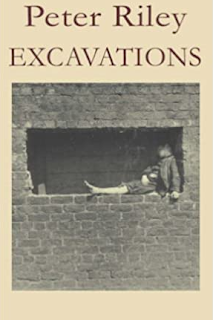The first hundred poems in Peter Riley's Excavations are meditations on prehistoric burials described by J.R. Mortimer in Forty Years’ Researches in British and Saxon Burial Mounds in East Yorkshire (1905); text in italics is mostly verbatim citation of Mortimer’s reports.
It’s impossible to read without wanting to contort one’s
body into the positions of the Neolithic and Early Bronze Age deceased
described within—preferably with a compass in hand, pointing one’s head
north-northeast and facing south-southeast, toward imagined origins. Conceivable
too the desire to dislocate one’s jaw to gorge on repasts prepared for eternity:
39. 40
Speech cancelled into music the lower
jaw removed and placed, intact, on the chest, teeth down. A small pottery
vessel was inserted in its place, touching the palate; its contents included
the bones of a small animal. And Lockd me up with a golden Key Head
to South facing upwards, legs flexed and turned to West young and slender
left hand thrust into groin, right arm across chest two yellow quartz
pebbles rounded with use just beyond the fingers of the right hand, beside the
left ear | sun pitch, clay star, black blade fracture – speechless with
horror. Bite my heart, three-personed sky, and I’ll earn a living, out in the
streets and bars of earth. And spend into the whole astrology, at speech’s
vigilant reprieve.
Of course the dead, famously, do not bury themselves, nor indeed
do their interrers typically write about the process—“Distance joins us by the
third person” (n. 6).
Each piece tends toward the opaque on its own; much like prehistoric
tumuli themselves, and archaeological phenomena in general, it is in the
aggregate that the mass of poems really begin to speak, with their repeated
chalk pavements, their curated dismemberment, flint-blade prosthetics and lost
eyes. Riley curates the bones of the past, defleshed and capaci—both capacious
and capable of—creative reappropriation, laid out with grave goods (“food,
rubbish, the usual suspects,” n. 11) in tableaux morts.
So far the first hundred, previously published as Distant
Points in 1995, are better than the new set, which follow William Greenwell’s
1877 British Barrows.


No comments:
Post a Comment